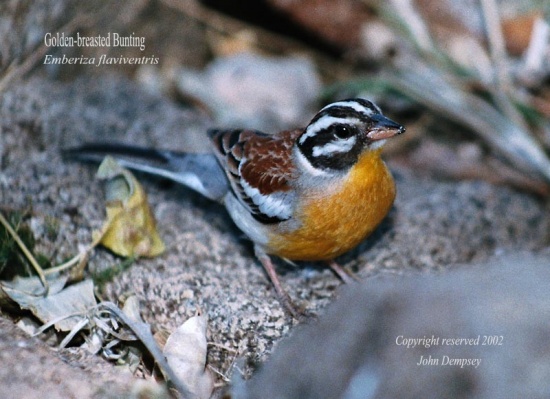(Attempt to disguise some copied text. Distribution, Taxonomy. References. Video link) |
|||
| Line 1: | Line 1: | ||
| − | |||
'''Alternative name: African Golden-breasted Bunting''' | '''Alternative name: African Golden-breasted Bunting''' | ||
| + | [[Image:African_Golden-breasted_Bunting.jpg|thumb|550px|right|Photo by {{user|jdbirdman|jdbirdman}}<br />Pilanesberg, [[South Africa]]]] | ||
;[[:Category:Emberiza|Emberiza]] flaviventris | ;[[:Category:Emberiza|Emberiza]] flaviventris | ||
==Identification== | ==Identification== | ||
| − | 15-16cm | + | 15-16cm<br /> |
| − | + | ''' Male''' | |
| − | + | *White crown | |
| + | *Black lateral [[Topography#Heads|crown stripes]] | ||
| + | *White [[Topography#Heads|supercilium]] | ||
| + | *Black-bordered white ear [[Topography#General Anatomy|coverts]] | ||
| + | *Orange-yellow underparts | ||
| + | *Yellow throat | ||
| + | *Whitish lower belly | ||
| + | *Chestnut upperparts | ||
| + | *Grey rump | ||
| + | *Brown wings with two white wing bars<br /> | ||
| + | Sexes are very similar, but '''females''' - buff tone to head, browner head stripes, and the back may have dark streaks.<br /> | ||
| + | '''Young''' birds are duller and paler than the females. | ||
==Distribution== | ==Distribution== | ||
| − | [[Africa]], south of the Sahara; absent from the equatorial forest belt. | + | [[Africa]], south of the Sahara; absent from the equatorial forest belt.<br /> |
| + | '''Western Africa''': [[Mauritania]], [[Senegambia]], [[Senegal]], [[Mali]], [[Liberia]], [[Burkina Faso]], [[Benin]], [[Nigeria]], [[Niger]], [[Chad]], [[Cameroon]], [[Central African Republic]], [[Equatorial Guinea]], [[Gabon]], [[DRC]] and [[Angola]]<br /> | ||
| + | '''Eastern Africa''': [[Sudan]], [[Eritrea]], [[Ethiopia]], [[Kenya]], [[Uganda]], [[Rwanda]], [[Burundi]], [[Tanzania]], [[Zambia]], [[Mozambique]] and [[Malawi]]<br /> | ||
| + | '''Southern Africa''': [[Namibia]], [[Botswana]], [[Zimbabwe]], [[South Africa]], [[KwaZulu-Natal]], [[Lesotho]] and [[Swaziland]] | ||
==Taxonomy== | ==Taxonomy== | ||
| − | There are | + | There are four subspecies<sup>[[#References|[1]]]</sup>: |
| − | *''E. f. | + | *''E. f. flavigaster'': paler, redder back, pale grey rump, paler yellow underparts and whiter flanks |
| − | *''E. f. | + | :*Southern edge of Sahara from [[Mauritania]] to [[Eritrea]] |
| − | *''E. f. | + | *''E. f. kalaharica'': |
| + | :*Southern [[Angola]] to south-eastern [[Sudan]], [[Kenya]], [[Mozambique]] and northern [[South Africa]] | ||
| + | *''E. f. flaviventris'': | ||
| + | :*Southern and eastern Cape Province to [[KwaZulu-Natal]] | ||
| + | *''E. f. princeps'': similar to nominate, but larger, and paler below | ||
| + | :*Northern and north-western [[Namibia]] to south-western Angola | ||
==Habitat== | ==Habitat== | ||
Dry open woodlands. | Dry open woodlands. | ||
==Behaviour== | ==Behaviour== | ||
| − | |||
| − | |||
It is normally seen alone, in pairs or small groups. | It is normally seen alone, in pairs or small groups. | ||
| − | + | ====Breeding==== | |
| − | + | They build a cup nest lined with fine grass or hair low in a shrub. The 2-3 glossy, black-lined, white or cream eggs are incubated for 12-13 days; the young fledge in another 16-17 days. | |
| + | ====Diet==== | ||
| + | A ground feeder, the diet includes seeds, insects and spiders and sometimes larger creatures when the birds have young to feed. | ||
==External Links== | ==External Links== | ||
{{GSearch|Emberiza+flaviventris}} | {{GSearch|Emberiza+flaviventris}} | ||
| − | [[Category:Birds]][[Category:Emberiza]] | + | <br /> |
| + | {{Video|Golden_breasted_Bunting}} | ||
| + | |||
| + | [[Category:Birds]][[Category:Emberiza]] [[Category:Videos]] | ||
Revision as of 23:59, 21 January 2012
Alternative name: African Golden-breasted Bunting
- Emberiza flaviventris
Identification
15-16cm
Male
- White crown
- Black lateral crown stripes
- White supercilium
- Black-bordered white ear coverts
- Orange-yellow underparts
- Yellow throat
- Whitish lower belly
- Chestnut upperparts
- Grey rump
- Brown wings with two white wing bars
Sexes are very similar, but females - buff tone to head, browner head stripes, and the back may have dark streaks.
Young birds are duller and paler than the females.
Distribution
Africa, south of the Sahara; absent from the equatorial forest belt.
Western Africa: Mauritania, Senegambia, Senegal, Mali, Liberia, Burkina Faso, Benin, Nigeria, Niger, Chad, Cameroon, Central African Republic, Equatorial Guinea, Gabon, DRC and Angola
Eastern Africa: Sudan, Eritrea, Ethiopia, Kenya, Uganda, Rwanda, Burundi, Tanzania, Zambia, Mozambique and Malawi
Southern Africa: Namibia, Botswana, Zimbabwe, South Africa, KwaZulu-Natal, Lesotho and Swaziland
Taxonomy
There are four subspecies[1]:
- E. f. flavigaster: paler, redder back, pale grey rump, paler yellow underparts and whiter flanks
- Southern edge of Sahara from Mauritania to Eritrea
- E. f. kalaharica:
- Southern Angola to south-eastern Sudan, Kenya, Mozambique and northern South Africa
- E. f. flaviventris:
- Southern and eastern Cape Province to KwaZulu-Natal
- E. f. princeps: similar to nominate, but larger, and paler below
- Northern and north-western Namibia to south-western Angola
Habitat
Dry open woodlands.
Behaviour
It is normally seen alone, in pairs or small groups.
Breeding
They build a cup nest lined with fine grass or hair low in a shrub. The 2-3 glossy, black-lined, white or cream eggs are incubated for 12-13 days; the young fledge in another 16-17 days.
Diet
A ground feeder, the diet includes seeds, insects and spiders and sometimes larger creatures when the birds have young to feed.
External Links




